![]()
![]()
![]()
Use LEFT and RIGHT arrow keys to navigate between flashcards;
Use UP and DOWN arrow keys to flip the card;
H to show hint;
A reads text to speech;
56 Cards in this Set
- Front
- Back
|
What are the inner planets in order from the sun? |
Mercury, Venus, earth, and Mars what plan |
|
|
What planets have rocky surfaces? |
All of the inner planets |
|
|
What planet is 70% covered with water? |
Earth |
|
|
What planet rotates in the opposite direction from most other planets and moons? |
Venus |
|
|
What planet is called the "red planets" because of the color of the dust? |
Mars |
|
|
What planets have at least one moon? |
All of the inner planets |
|
|
Which planets are similar to each other in size, density, and internal structure? |
Earth and Venus |
|
|
What planet has almost no atmosphere? |
Mercury |
|
|
What planet's atmosphere is so heavy and thick that it would crush a human? |
Venus |
|
|
Which planets have a tilted axis that causes seasons? |
Earth and Mars |
|
|
Which planet's atmosphere has low air pressure and is mostly carbon dioxide? |
Mars is made of 95% carbon dioxide |
|
|
Terrestrial planets |
Inner planets |
|
|
Green house effect |
The trapping of heat in a planet's atmosphere |
|
|
What are the outer planets in order from the sun? |
Jupiter, Saturn, Uranus, and Neptune |
|
|
Which planets are the gas giants? |
All outer planets |
|
|
Differences between Pluto and gas giants |
Pluto has not cleared its orbital pathway and is in the Kuiper belt |
|
|
Why doesn't the gas on a gas giant escape into space, as it Jason Mercury? |
The gravity is pulling it in |
|
|
What object in the solar system has a composition similar to that of the gas giants? |
The sun |
|
|
What planet is the largest planet to revolve around the sun? |
Jupiter |
|
|
What are Saturn's rings made out of? |
Dust, ice, and rocks |
|
|
How did astronomers know where to look to discover Neptune? |
A mathematical prediction |
|
|
Gas giant |
Don't have solid surfaces All outer planets |
|
|
Ring |
A thin disk of small ice and rock particles surround a planet |
|
|
Asteroid vs meteoroid |
Meteoroids are dust and rock that are smaller than an asteroid |
|
|
Asteroid |
Rocky abject a that are too small to be planets |
|
|
Meteor |
When a meteoroid enters earths atmosphere, and burns up and produces light |
|
|
Comet |
A chunk of ice and dust whose orbit is usually a long and narrow ellipse |
|
|
Meteorite |
When a meteoroid hits Earth's surface |
|
|
Asteroid |
A rocky object that revolves around the sun between 10 and 15 feet |
|
|
Meteoroid |
A chunk of rock or dust in space that is small than 10 feet in diameter |
|
|
Asteroid belt |
The region of the solar system between the orbits of mars and Jupiter |
|
|
Coma |
Clouds of gas and dust on a comet form a fuzzy outer layer |
|
|
Oort Cloud |
A spherical region that defines the outer limit of our solar system |
|
|
Kuiper belt |
A doughnut shaped region that begins outside near Neptune's orbit |
|
|
Red giant or supergiant |
D |
|
|
Location and movement of an asteroid |
Revolve around the sun Asteroid belt Kuiper belt |
|
|
Where fusion begins |
B |
|
|
Part of a nebula |
A |
|
|
White dwarf, neutron star, or black hole |
E |
|
|
The stage the sun is in |
C |
|
|
How a star exists depends on its... |
Mass |
|
|
Pulsar |
Appears to emit pulses of radio waves |
|
|
White dwarf |
What a medium mass star becomes at the end of its life |
|
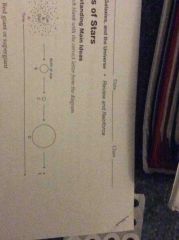
Red giant or supergiant |
D |
|
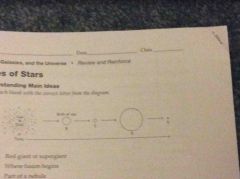
Where fusion begins |
B |
|
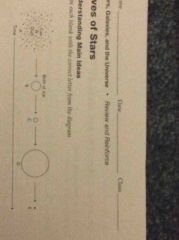
Part of a nebula |
A |
|
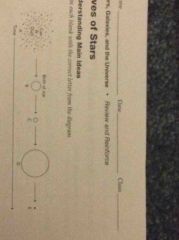
White dwarf, neutron star, or black hole |
E |
|
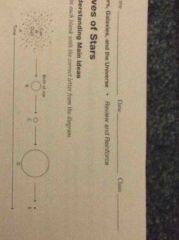
The stage the sun is in |
C |
|
|
Black hole |
Exerts such a strong gravitational pull that no electromagnetic radiation can escape |
|
|
Meteoroids and location and movement |
A chunk of rock or dust on space Collide with objects Asteroid belt Kuiper belt Oort Cloud |
|
|
What causes a meteoroid to become a meteorite? |
A meteoroid become a meteorite when it comes in contact with earth's ground |
|
|
Parts of a comet: head |
The coma |
|
|
Parts of a comet: coma |
He outer layer of a comet |
|
|
Parts of a comet: nucleus |
The rock |
|
|
Parts of a comet: the tail |
Is the light |
|
|
How can you tell a comet from a meteor? |
A comet lasts longer |

